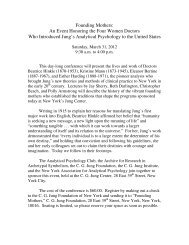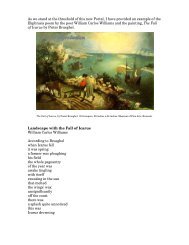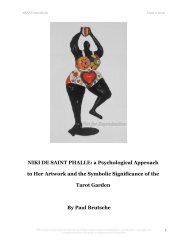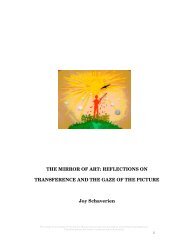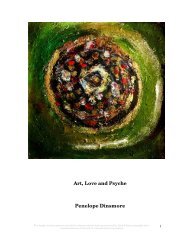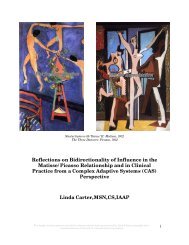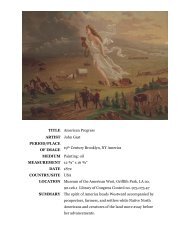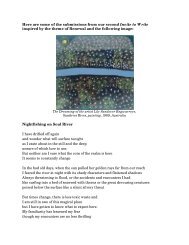Pictorial Space throughout Art History: Cézanne and ... - ARAS
Pictorial Space throughout Art History: Cézanne and ... - ARAS
Pictorial Space throughout Art History: Cézanne and ... - ARAS
You also want an ePaper? Increase the reach of your titles
YUMPU automatically turns print PDFs into web optimized ePapers that Google loves.
<strong>ARAS</strong> Connections Issue 2, 2012<br />
painting as a new individual with its own integrity. Only then can the artist<br />
respond to each painting's unique structural problems. Thus pictorial space is the<br />
antithesis of a formula.<br />
Does a preoccupation with pictorial space make art too studied <strong>and</strong><br />
prevent the artist from being playful in his or her creative work? In fact, when a<br />
painter focuses on the spatial problem, there are endless possibilities for play,<br />
that is, for trial-<strong>and</strong>-error, change, <strong>and</strong> evolution. No other aspect of painting,<br />
neither drawing, nor composition, nor perspective, nor color effects, nor subject<br />
matter, can be pursued for so long with so many incremental developments.<br />
When an artist bases a painting upon these other aspects, then he or she can only<br />
develop it to a limited extent. It becomes “finished” <strong>and</strong> the artist is forced to go<br />
on to a new painting. The problem of pictorial space, however, is inexhaustible,<br />
like a child's play. <strong>Cézanne</strong> would spend several years on a single canvas.<br />
To use the word in another sense, movements play continuously against<br />
each other <strong>throughout</strong> a plastic painting. The surface ripples. The canvas<br />
recreates itself as it is observed, as though it were a three-dimensional mobile<br />
(Plate 12).<br />
Contemporary art often disregards pictorial space. Perhaps pictorial space<br />
is out of date <strong>and</strong> no longer important? It is hard to compare new art with art that<br />
has endured for hundreds of years <strong>and</strong> each of us must decide for ourselves what<br />
we value. It remains objectively true that, if a painting has four sides <strong>and</strong> a flat<br />
surface, then it cannot be fully unified unless it relates to those limits.<br />
<strong>Pictorial</strong> space is subjective in the sense that it must be experienced <strong>and</strong><br />
cannot be measured, but objective in the sense that it is independent of<br />
The images in this paper are strictly for educational use <strong>and</strong> are protected by United States copyright laws. 39<br />
Unauthorized use will result in criminal <strong>and</strong> civil penalties.



